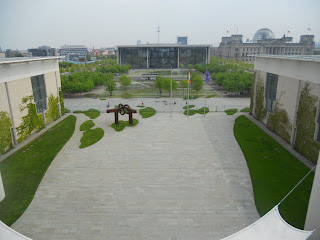A few weeks ago I travelled to Berlin, the capital of Germany as part of a school activity. I had some preconceived notions of Berlin from movies that I have seen. I pictured a very quite and dull city where the people did not speak to others much and everything was run down and old. I was very wrong about my prediction but I imagine that when the wall was still up, dividing East Berlin from West Berlin, that the movies depicted a very real and devastating time for Germany.
As part of the school trip I went a visited several government buildings such as the Parliament and the German Chancellery building. We also visited the headquarters of the Deutsch Bann, which is the main train system in Germany and a television station in Berlin. And obviously the biggest part of the trip was visiting the Berlin Wall memorial and the Stasi Prison. During the afternoons and evenings we had our own time to do what we wanted. One afternoon we went to the Berlin Zoo which we heard was comparable to the San Diego Zoo (Nope, not nearly as good as SD). The rest of the evenings we went to pubs, restaurants, and hookah lounges where they served grape leaves and hummus.
There was so much history and events that were done throughout the week that I have to break this blog into several different sections. I will start with the government buildings and the trips to the television and train station headquarters.
This is the me in front of the German Chancellery building.
The German Chancellery was originally established in the 1800's and was destroyed during World War II. After the destruction of the Chancellery by the Soviets, Bonn became the new residence for the Chancellors from the 1950's to 1999. At this point, the new Chancellery building was built and that is what you see in the picture below.
I did not get any good pictures of the side of the building, but the design of the building has a lot of abstract like the grass areas seen in the picture above. The design of this was based on showing the unity between East and West Berlin. Before the wall came down everything on the East side of Berlin was colorless, uniform, and boring. This new design for the Chancellery building shows the unity of Berlin today. Locals refer to the building as the "Washing Machine" because of the designs on the side looks similar to a front loading washing machine. The sides of the building have many holes in the structure as part of the design. The locals also make jokes that the holes in the building represent the holes in the budget.
Today the head of the German Chancellery building is Angela Merkel. She is the first female Chancellor. Back in the early 1900's, Adolf Hitler was the head of the Chancellery. Every Chancellor has a box representing the dates of who was in charge at the time. The picture below shows this.
I was very lucky to have a chance to tour the inside of the building because only 60,000 students see the inside of the building each year. Here is what I saw.
The next place that we visited was the German Parliament called the Bundestag. In 1933, there was a fire that was infamously named the Reichstag fire. This fire was the symbolic of the Nazi's overthrowing the government. The building was also destroyed in World War II, but they preserved several walls in the building that had signatures of Soviet soldiers. They decided to not cover up these walls to really show the history of the building.
The final two places I did not take pictures of. It was interesting to know that in East Berlin there was a height restriction, that buildings could not be any taller than the capital building which was four stories tall. That was in effect until the Berlin Wall came down. Following the law, the television station needed to expand so they went underground and utilized the court to televise television show. Very impressive.
The Deutsch Bann is a vital to the transportation throughout Germany and much of Europe. If you are planning to travel to Germany, chances are you will enjoy a train ride on the DB.









No comments:
Post a Comment